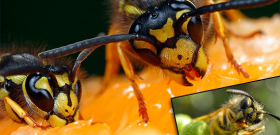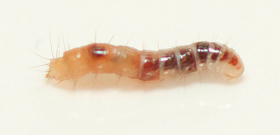
Wasp larvae differ from adult insects in much the same way that caterpillars differ from butterflies. And the reason for this is the so-called complete transformation, characteristic of all wasps and their relatives: ants, bees, bumblebees, riders. While the adult is a mobile, rather aggressive and strong insect, the wasp larva, on the contrary, is inactive and is not able to feed and take care of itself.
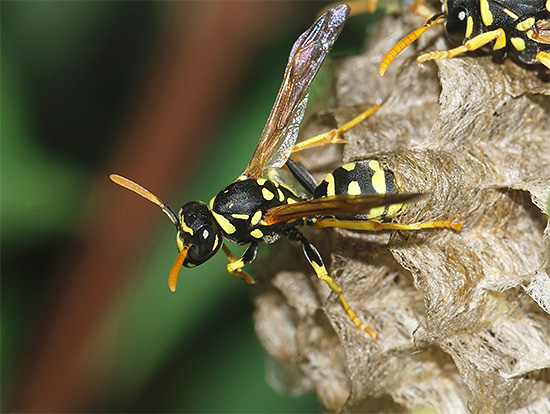
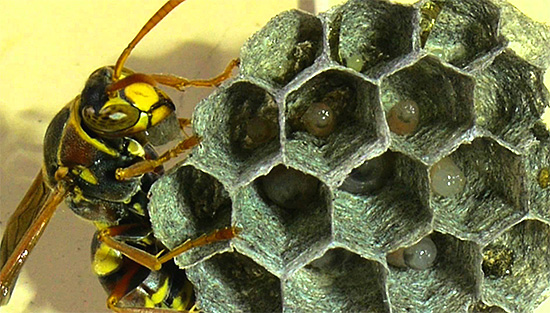
This state of affairs is beneficial from an ecological point of view: adult wasps and their larvae feed on different foods and thus occupy different positions in the food chains. So nature made sure that adult wasps and their offspring do not compete with each other for food and make the most complete use of food resources in the areas where they live.
It is interesting
The difference in the diets of wasps at different stages of development has reached the point that the larvae of many of them cannot digest plant food at all - there are no enzymes in their digestive tract that can break it down.
The larvae of different species of wasps differ from each other much less than they differ from adults of their own species. Although, due to the difference in size between individual species, the larvae can also resemble David and Goliath when compared.
An interesting photo - a giant Asian hornet eats paper wasp larvae:

And now let's take a closer look at wasp larvae (especially since in real life this can be very unsafe).
Appearance, size and color of wasp larvae
The larvae of most species of wasps look the same, and the differences in their appearance are mainly only in size.
The larva has a thick, rounded body in cross section, on which several segments are clearly visible. And she does not at all look like a slender adult insect with a thin waist. The legs of the larva are usually reduced, and it can crawl only by wriggling (as a rule, future predators at this stage of their development do not need any distant movements at all).

In the photo - larvae of an ordinary wasp (paper), already ready for pupation. Their length is now slightly less than the length of an adult insect, but the body thickness is much greater than that of slender parents:

The larvae of most wasps are white or light yellow in color. Due to the fact that adult insects protect their offspring and hide them in well-camouflaged nests, their larvae do not need protective coloration.
In the photo - a larva of an earthen wasp eating a spider paralyzed by its mother:
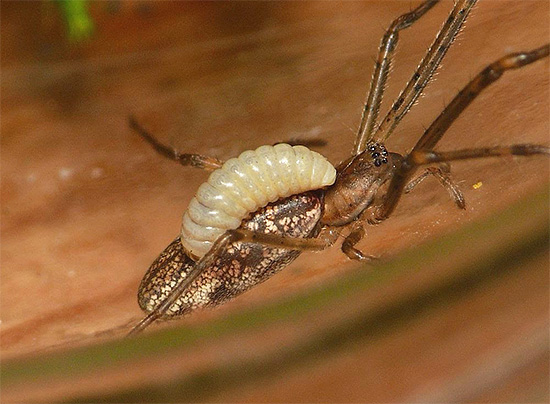
The head of the wasp larva is so small that it can hardly be seen at the front end of the body. In fact, most of the head is occupied by the jaws, allowing you to eat, albeit soft, but still requiring chewing animal food.
What do wasp larvae eat?
Oddly enough, but for all their sluggishness, wasp larvae are insectivorous, although they do not hunt on their own, but feed only on those insects that adults bring them. The difference in feeding patterns between species is mainly whether the larvae feed themselves or are fed.
The brood is fed by social wasps:
- paper;
- European and Asian hornets;
- Polybean wasps in the USA.
Their larvae almost do not move their bodies at all, and can only rotate their heads, peeking out of the honeycomb.
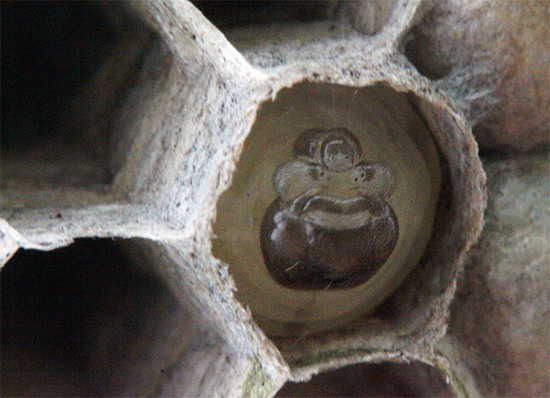
Adult wasps of these species feed on the nectar of flowers, sweet juices of berries and fruits, but for the younger generation they catch insects, chew them and feed them in the form of a mushy mass.
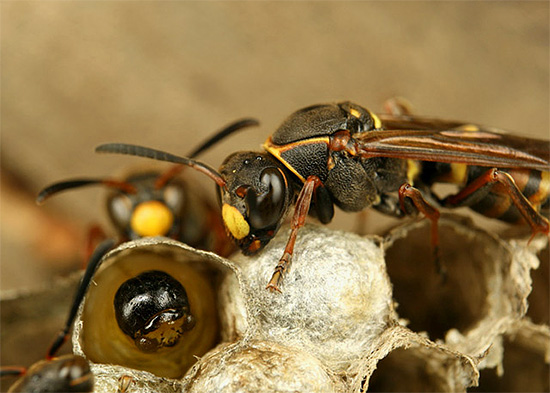
It is interesting
Larvae of social wasps do not excrete excrement, accumulating them in their body until they hatch from the pupa. After the young wasp leaves the cell, the working individuals clean out everything that the “heiress” has left from there.
In the photo - the head of a wasp larva at high magnification:

In most solitary wasps, the female prepares for the larvae a small nest in the form of a mink in the ground or a small paper shelter attached to a vertical surface. The female brings a paralyzed but not poisoned insect into this chamber and lays an egg on it. The wasp larva hatched from the egg slowly eats the insect, and begins to do so from those organs, the loss of which does not lead to the instant death of the victim.
In some of these wasps, the female sacrifices once, lays an egg, and clogs the burrow. In others, an adult may visit the nest from time to time and bring additional insects into it.
It is interesting
The list of creatures that wasps can feed their brood with is extremely long.Social species are universal in this regard - they catch almost any caterpillars, butterflies, cockroaches, larvae of other insects, mollusks, slugs, bees, spiders and bedbugs, and large hornets - even small lizards and mice. Solitary wasps are more highly specialized: some species prey only on spiders, others exclusively on bugs or beetle larvae.
There are also primitive wasps that do not make nests for their larvae. These include, for example, scoli, one of the largest wasps in the world.
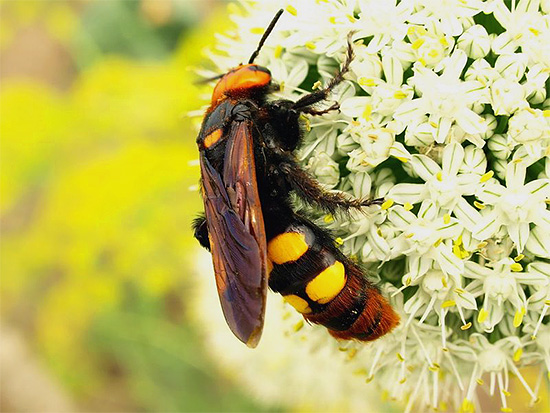
An adult female scolia digs in the ground near the roots of plants in search of beetle larvae. Finding a victim, she paralyzes it and lays an egg on it. After that, the predator flies away in search of new prey. The larva feeds where its food remains.
Meanwhile, there are among the wasps and parasites. For example, some species of wasps lay their eggs directly on living insects, and after hatching, the larvae penetrate the body of the victim and slowly eat it alive from the inside. Sooner or later, the victim dies.

It is noteworthy that German wasps parasitize the larvae of other wasps, usually social ones, making their way into their nest and laying eggs in the combs.
Development and transformation into adult insects
Thanks to a fairly wide and thick body, wasp larvae do not fall out of the combs, the neck of which looks down. The insect literally clogs the honeycomb with itself, and after leaving the chrysalis, the young wasp simply straightens its body and calmly leaves its cradle.
It is interesting
Initially, the wasp glues the egg to the wall of the honeycomb, and the larva, until it grows fat, is kept here precisely due to this glue. When her weight becomes too large, she already has a wide enough waist so as not to fall out of the cell.
The photo shows honeycombs from which the heads of the larvae stick out:

The development of wasp larvae proceeds quite quickly. For example, with abundant feeding, the larva of European hornets goes through five larval stages with four molts in just 12-14 days, after which it spins a silk cocoon around itself and pupates. About two weeks later, an adult insect emerges from the pupa.
Wasp larvae as food reservoirs for adult insects
Interestingly, in times of famine, adult wasps belonging to collective species can use larvae as food sources (more precisely, nutrient fluids they secrete).
At each feeding, the adult individual passes the chewed food to the larva, and the larva in response secretes saliva, which the feeder himself regales on. Even if the adult wasp did not bring food, the larva will still share the secret with it. This phenomenon is called trophallaxis, and is a way to maintain the viability of an entire colony of insects during periods of prolonged rains or cold snaps in the north.
The photo shows how an adult wasp feeds the larvae:
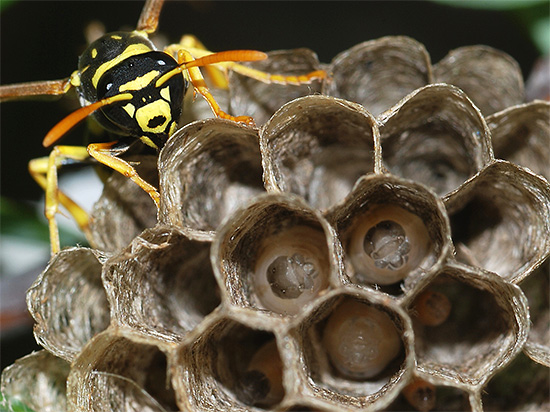

Finally, the wasp larvae themselves are of gastronomic interest for many animals. Birds (for example, bee-eaters) willingly steal larvae from nests that begin to build. Bears and honey badgers are also happy to destroy such nests.
And in Japan, there is a traditional dish called jibatinoko, which is wasp larvae boiled with sugar and soy sauce.
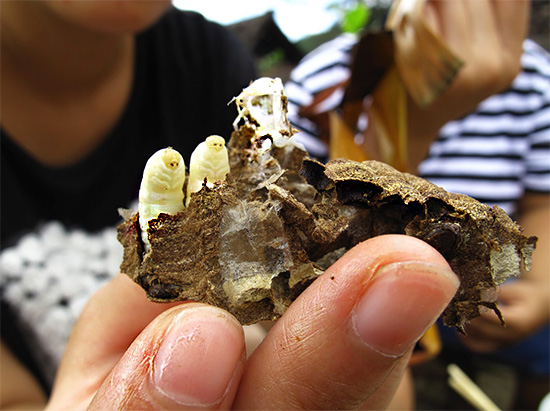
In the difficult war years, it was insects that allowed many Japanese not to die of hunger.
A hornet's nest that was destroyed by accident: close-up video showing thick moving larvae

